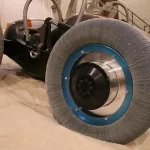
Transportation Rounds
January 12, 2024
Moving on Truck Stops
January 26, 2024Tech That Doesn’t Overtake

Who – or What – Will Deliver Your Milk?
The arguments against fully autonomous vehicles and trucking fleets are compelling.
For drivers, there’s the less-than appetizing idea that they could be replaced by a system of computers, algorithms, and GPS locators.
For third-party logistics, there’s the unsettling idea that, even though an autonomous vehicle could ping out its location (maybe even quicker than a driver on the phone), we’d have less access to the nuances of any given movement of freight.
For the customers, there’s the unnerving prospect that their valuable load is going to be delivered by The Terminator.
The arguments for fully autonomous vehicles are also compelling.
For fleets, the initial startup cost of converting the vehicle would eventually be gained back when payroll declines. Less salary, less medical coverage, less workman’s comp. The Terminator may not be subject to the same hours of service ceilings as humans are. The Terminator doesn’t need a rest stop for bathroom, food, or sleep.
For highway safety, if ⏤ and this is a big if ⏤ the technology proves solid, roads stand to be safer for everyone. Human error does cause a large percentage of accidents.
For the customers, often at the start and the end of the day, their priority is getting that valuable load delivered, and safely.
Right now, there are too many questions and uncertainties. How do people driving their own vehicles interact with autonomous vehicles? Maybe more importantly: how do autonomous vehicles interact with people? If autonomous trucking takes hold, what becomes of our human workforce that’s been the backbone of the industry since horse and buggy days?
And so, maybe, a compromise.
Check out the brief video below from our friends at Transport Topics. Advanced Driver Assistance Systems (ADAS) seem to be advancing in ability and benefit. Communication speed between elements like cameras and radar are improving, along with “better sensors, detection of traffic signs, vulnerable road user detection, and road disturbance calibration.”
We’ve seen the flashing lights in action on our side mirrors. The vehicle alerts us that we’re getting too close to the edge of our lane or that another vehicle is approaching in our blind spot.
Imaging enhancing such a feature, and more: not for autonomous vehicle design but for assistance to us humans as we roll along the nation’s roads. That technology exists. Here’s hoping it’s put to better, and then excellent, use.

